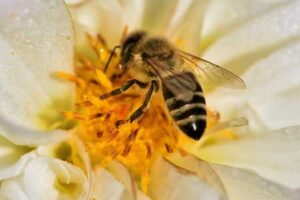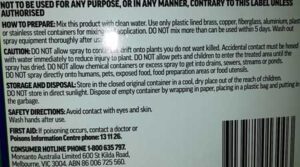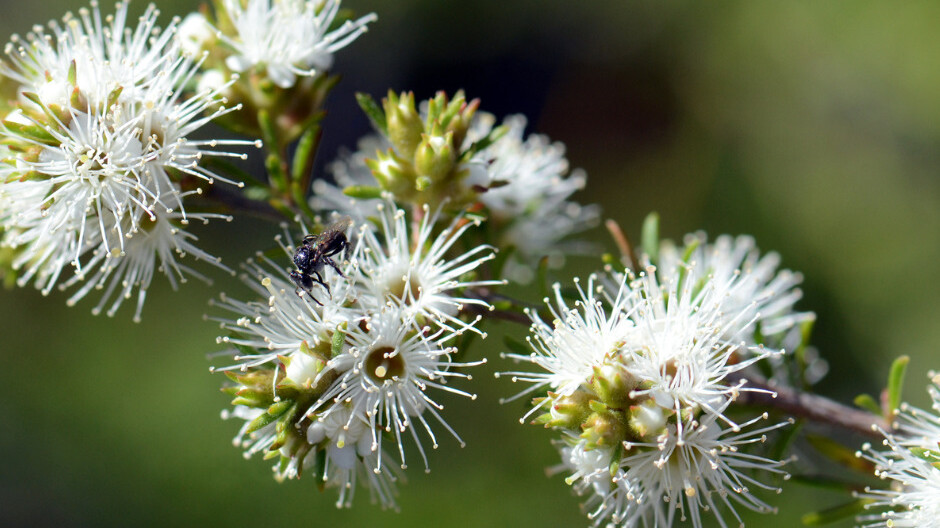Pesticide use is one of the factors which may be affecting bee populations worldwide. Since much of our food production depends on pollination by bees, whether bee populations have been declining globally has been the source of concern – and some confusion. While there have been reports of declining bee numbers it is now thought that these are the result of local population changes and declining species richness i.e. of particular species of bee. As well as pesticide use, the cause of such declines could result from the virus carried by the Varroa mite, climate change or habitat loss, or a combination of all four factors. In Australia, we now need to pay more attention to the threat of pesticides since, with the detection of Varoa mite in Victoria in 2018, honeybee populations are more threatened. So here we look at the pesticides most harmful to bees. We might immediately think “neonics”, but while it is true that these are toxic for bees, there are many others which kill both honeybees and native Australian bees.
In SGA’s app WiseGardening – Choices to Protect You and the Planet, where we rate risks of chemical pesticide products, we have included the full range of products in garden use. Five hundred and twenty seven products out of the 869 reviewed so far have either moderate or high risks to bees. There are 304 with high risk and 223 with moderate risk. Of those 527 products with moderate or high risk to bees, there are still 318 commercially available and 209 have been discontinued. Of those currently available, 181 are high risk to bees and 131 are of moderate risk.
Neonicotinoids (Neonics)
As the name suggests, these chemicals are similar to nicotine and they react with the same nerve receptors in nerve junctions as nicotine does. This enables them to cause paralysis and death. They are more toxic to insects than they are to mammals and birds.
Acetamiprid
Clothianidin
Dinotefuran
Imidacloprid
Nitenpyram
Thiocloprid
Thiamethoxam
These chemicals have an advantage as insecticides because they are water-soluble and, if sprayed on the soil, plants can easily take them up. In theory, this reduces the risk of unwanted effects on beneficial insects caused by broadscale spraying and consequent spray-drift. However, their solubility means that they can enter and be stored in pollen and flower nectar, placing pollinators such as bees at risk. These soluble chemicals are also very toxic to aquatic organisms when excess enters waterways. Searching for these chemical names in WiseGardening reveals products containing them and their risks.
The Australian Pesticides and Veterinary Medicines Authority (APVMA) which regulates pesticide standards states “All neonicotinoids registered for use in Australia have previously been through the Australian Pesticides and Veterinary Medicines Authority (APVMA)’s chemical risk assessment process..” A review of neonicotinoids started in 2019 is still in progress. Neonicotinoids are some of many pesticides which are permitted in Australia but banned overseas e.g. in UK and EU. Although some neonicotinoids are available for farming use, many retailers have withdrawn them for sale for household and garden use.
Organophosphates
These chemicals have been widely used in the past because of their effectiveness against a variety of pests. Because they are extremely toxic neurotoxins and have high persistence in the environment many are now banned. Perhaps best known is DDT used widely against mosquitoes – it is now withdrawn from sale.
Most are now banned overseas, but products containing malathion, chlorpyrifos, dichlorvos and diazinon are commercially available in Australia – mostly as dusts, and powders to control lawn beetles, grubs, slaters, termites and ants. Some are in fruit fly traps or pest strips which don’t carry quite so much risk since they are not sprays which can disperse. However, because of their persistence, residues can be picked up by bees. Although most products containing organophosphates are now discontinued, some still lurk in garden sheds and garages. When you search WiseGardening. for the chemical ingredient names you will see that they pose high risks to a variety of organisms, including humans.
Pyrethrins
These are a family of products, some natural and others synthetic, and include permethrin, cypermethrin, bifenthrin, phenothrin and deltamethrin. Many of us think that products containing pyrethrin or something that sounds similar, are natural and, therefore, safe. But this is not the case.
 There is confusion about terminology of pyrethrin (natural) and pyrethroids (synthetic). The latter are particularly toxic to bees. They affect the nervous system by changing activity of nerve sodium channels. They are more effective on insects because they have greater affinity for insect nerves and are active at the lower temperatures of cold-blooded insects in comparison to warm-blooded mammals.
There is confusion about terminology of pyrethrin (natural) and pyrethroids (synthetic). The latter are particularly toxic to bees. They affect the nervous system by changing activity of nerve sodium channels. They are more effective on insects because they have greater affinity for insect nerves and are active at the lower temperatures of cold-blooded insects in comparison to warm-blooded mammals.
A search on WiseGardening reveals a large number of commercially available products containing pyrethrins which pose high risks to bees and other organisms. If using these products, avoid spraying during the day when bees are active and wait until bee-attracting flowers are no longer present. Since pyrethrins are not persistent in the environment, the effects of residues wane after about one week.
Fipronil
Like the above chemicals, fipronil affects nerve systems but by changing the activity of the chloride channels. It was introduced to the market in 1996, predominantly to control indoor insects (e.g. moths and fleas), spiders and rodents. It can affect mammals and humans, but only at much higher concentrations.
In WiseGardening, 16 commercially available products containing fipronil and one which is discontinued have high risks for bees, birds and mammals and moderate risks for fish and earthworms.
Sulfoxaflor
A relatively new pesticide based on sulfoxaflor was released in the USA in 2013 and subsequently in Australia. It is one of many pesticides which are permitted in Australia but banned overseas e.g. in UK and EU Currently, it appears to be only available for agricultural and horticultural use and not in gardens.
Other chemical ingredients toxic to bees in pesticides in Australia
Apart from those chemicals discussed above, there are many other pesticides available for use in horticultural and agricultural industries which contain ingredients which are toxic for bees. A list of those known in 2014 is here.
 What you should do
What you should do
Many of us try to avoid chemical pesticides altogether. But that is not always possible when a whole crop of lovingly-grown fruit or vegetables is being attacked. So consult SGA’s WiseGardening app and, as we point out, PLEASE READ PRODUCT LABELS with respect to guidelines for use. But don’t just rely on the product label because those labels do not show toxicities to the full range of organisms covered in WiseGardening.
Related Articles:
Wildflower gardens – What’s the buzz about?
In the quest for sustainable and environmentally conscious practices, gardening enthusiasts and nature lovers alike are turning to a time-tested…
Garden Journaling – Slow down to tune in.
As we move through the year and our gardens evolve, there's something magical about documenting the journey. Garden journaling is an art that enables…




